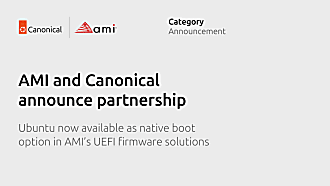Gokhan Cetinkaya
on 28 October 2024
Unleash new ways of working with flexible, cost-effective VDI
Empower your modern workforce with VDI from HPE, Canonical, and HP Anyware
For years, virtual desktop infrastructure (VDI) has helped power the most complex IT environments—and the technology is still relevant today. After all, VDI allows employees to access their work applications and data across any device, anywhere. And the growth of 5G networked edge computing means that VDI workloads can soon be optimised for even greater flexibility, security and cost savings.
But what’s the right way to deploy VDI in the cloud era? To support the latest remote and hybrid working models, organisations need a modern, open-source VDI framework that’s built to deliver business value.
Today’s blog looks at why companies are embracing modern VDI solutions for hybrid work, outlines the value in open source virtualisation, and explores how the VDI framework from HPE and Canonical delivers the speed, security, and scalability to meet the demands of a rapidly changing business world.
Read the VDI from HPE solution brief
Why a modern VDI framework matters
Thanks to the trends of remote and hybrid work, VDI adoption is more popular than ever. Gallup research shows that 53% of U.S. employees work in a hybrid model, with another 27% working remotely. As a result, organisations and their IT leadership must support these users’ needs regardless of the location, while also ensuring productivity and security for the business.
To put it simply, modern VDI solutions empower modern businesses, especially when data integrity and other security concerns are paramount. Key advantages of using a modern VDI framework include:
- Enhanced productivity: Employees can seamlessly access applications and data from anywhere, using any device—with optimised performance.
- Simplified management: VDI solutions enable IT to centrally manage desktops, eliminating the need to install, update, and patch applications, back up files, and scan for malware on individual devices.
- Increased security: VDI delivers inherent security, because employees aren’t carrying around confidential data on a device that could be lost, stolen or tampered with. Plus, data is backed up centrally and regularly in the data center or cloud. Modern VDI solutions also provide a Zero Trust architecture to strengthen data protection.
- Reduced costs: Virtual desktops can help reduce IT maintenance and administration costs, which are a significant portion of the total cost of ownership (TCO). VDI also minimises license operating expenses in a distributed environment.
What’s more, the rise of 5G connectivity has improved VDI performance for remote users. The low latency and fast connectivity of 5G networks is especially beneficial for power users, who can work more effectively in graphics-intensive applications in a 5G VDI environment.
The added value of open source virtualisation
VDI solutions running on open source technologies enable your IT teams to adapt more efficiently to changing needs. With open source virtualisation technologies, you can count on:
- Reusability of known and proven technology. Open source solutions are at the core of cloud computing. They’re easier to integrate with other standards-based tools and remove the risk of vendor lock-in.
- Simplified management. Open source technologies, backed by Canonical’s 12-year support commitment, minimize maintenance needs and manual intervention, with automation tooling to ensure easier long-term management.
- Security and compliance at the edge. Open source solutions backed by commercial support provide the best of both worlds. Control over data privacy and governance is retained by your organisation. Meanwhile, Canonical provides long-term security maintenance for added peace of mind.
Modernise VDI with HPE and Canonical
For a modern VDI framework, HPE and Canonical work together across the stack to deliver the best performance, security and manageability for a changing workforce. The VDI solution builds upon the robust capabilities of HPE ProLiant servers—coupled with Canonical MicroCloud and HP Anyware software—to deliver a comprehensive approach for modernising your IT ecosystem.
Here’s how the VDI solution layers come together:
- Compute foundation: HPE ProLiant Gen11 Servers. At the hardware infrastructure layer, HPE ProLiant Gen11 servers provide world-class performance for hybrid computing environments, an intuitive cloud operating experience, and trusted security by design. Ultra-scalable CPU architectures and significantly increased GPU density deliver the performance power users need—even for industry-specific certified solutions. And the servers are engineered with a Zero Trust security approach that hardens your compute core against threats on hardware and firmware to third-party software risks.
- Virtualisation layer: Canonical MicroCloud. At the virtualisation layer, Canonical MicroCloud is highly available by default. It uses redundant server clusters that can be scaled from small 3-node clusters to large 50-node clusters.
- VDI control plane: HP Anyware. For VDI delivery, HP Anyware supports end-user devices running almost any kind of OS, including Windows, Mac, Chrome, iOS, and Android as well as zero and thin clients. At its core, HP Anyware harnesses the robust PC over IP (PCoIP) protocol, helping ensure a superb user experience across a diverse range of devices, with secure connectivity from virtually anywhere.
Deploying the right VDI solution for your needs
With the VDI solution from HPE and Canonical, your organisation can count on the right technology for your changing needs. The VDI solution delivers uncompromised performance and a consistent workspace experience for hybrid workers, even for power users with advanced compute demands.
What’s more, the modern VDI solution from HPE and Canonical combines workload flexibility, built-in security, and cloud-native management to optimise investments. It’s designed to help drive innovation from the edge to the cloud.
To learn more about how HPE ProLiant servers, coupled with Canonical MicroCloud and HP Anyware, can transform your business operations, click on the button below to read the solution brief from HPE.



